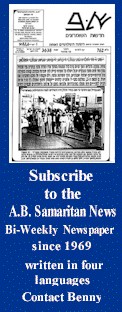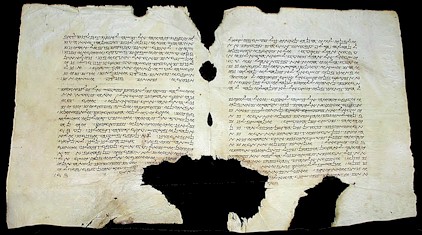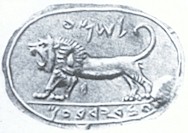|
In This Issue
-
Orlando Visit
-
The Seal
-
Notes and Extracts
The Samaritan Update, is a
Bi-Weekly Internet Newsletter, a Division of The-Samaritans.com.
Subscription is free via E-mail only.
-----
Editor: Shomron
Co-Editor: Osher
Sassoni
Staff Writer:
Staff Photographer:
Eyal
Cohen
Staff Translator:
Guy Tsabary
Special Contributors:
A. B. - Samaritan News
----
Contact information:
The Editor
Your link
to the Update Index
and to our
Web Site: The-Samaritans.com
Subscribe To the Bi-Weekly Newsletter -The
Samaritan Update.
Sign Up !
For More Information
Donate to The-Samaritans.com

Sunset Times for Central Israel
calculated by Abraham Cohen from Holon
Sabbaths
begins Friday Dec. 5th, 4:36pm to Saturday 6th, 4:36 p.m.
19th 4:40 pm- 20th 4:40 pm
Samaritan Calendar
of Festivals
Next fest: Passover
May 3rd, 2004
Samaritan
Studies and Related Conferences:
In
Planning Stage
SES:In Haifa, July 5-8, 2004
organised by
Menahem Mor, and a session at the EABS
in Grooningen, July 25-28,
2004 organized by Ingrid Hjelm
Do you have a question that you would like
to ask:
Join Us at
The-samaritans
Discussion
Forum!
Plan on buying a
Book? Buy through us and support our main website:
www.the-samaritans.com


|
Orlando
Visit
By Shomron
This past week
presented a nice surprise. Benny Tsadaka visiting Orlando, Florida met
with two of his friends, Stephan Huller of Canada and myself (Shomron).
Various conversations on many topics were discussed. But the most
 surprising to Benny and myself was
when Stephan Huller took us to a tourist park, The Holy Land Experience. What
was the surprise you might wonder? Well, Stephan had visited the park with some
friends a while back and knew we would enjoy what he had discovered there. In
the Sola Scriptura, a building designed for displaying Bibles in their
possession. In this building was a 13th century Samaritan Manuscript. It
contacts 4 pages of book form, a section of Numbers partly describing the death
of Aaron the High Priest. We were amazed, since neither Benny nor I knew of any
Samaritan Manuscripts in Orlando, Florida. For me, I was amazed since I had
contacted them about a year and a half ago and had asked them if they had any
Samaritan manuscripts in their possession. They had at that time informed me
that there were none in their collection. surprising to Benny and myself was
when Stephan Huller took us to a tourist park, The Holy Land Experience. What
was the surprise you might wonder? Well, Stephan had visited the park with some
friends a while back and knew we would enjoy what he had discovered there. In
the Sola Scriptura, a building designed for displaying Bibles in their
possession. In this building was a 13th century Samaritan Manuscript. It
contacts 4 pages of book form, a section of Numbers partly describing the death
of Aaron the High Priest. We were amazed, since neither Benny nor I knew of any
Samaritan Manuscripts in Orlando, Florida. For me, I was amazed since I had
contacted them about a year and a half ago and had asked them if they had any
Samaritan manuscripts in their possession. They had at that time informed me
that there were none in their collection.
The next day we
contacted the curator of the Sola Scriptura, Herbert Samworth. Dr.
Samworth informed us that, "Unfortunately, I am unable to give you much
information concerning the manuscript except to say that it was purchased a
number of years ago at an auction sale. Provenance is listed as "probably
Nablus" and dated early 13th century." We have contacted the Auction House and
hope to hear more information from them on the Samaritan Manuscript in the near
future. We want to thank Dr. Samworth for the above photo in which we hope to
learn more of their manuscript. Thank you Stephan Huller for the nice surprise!
I thought I would
spare one conversation with Benny Tsadaka on his eating habits in the States. On
eating any type of meat: No meat can be eaten even if he was to slaughter it,
keeping it kosher, would not be allowed since he could not give the Priests
their portion. But fish is acceptable since it is not considered meat.
----------
The Seal
By Shomron
Have you ever
come across the seal (shown in the photo to the left) that was
 discovered at Megiddo in 1904
by G. Schumacher. It depicts a roaring lion with an inscription that has
been translated, "To Shema" with "servant of Jeroboam." "From the shapes
of the letters, we know that that the king in this case is Jeroboam II,"
says G. E. Wright. But the importance of this seal is the word "Shema,"
the same word used still today by the Samaritan-Israelites meaning "the
name," the name of God. It has been assumed by scholars that this name
"Shema" was the name of a servant of Jeroboam. But what if it was, as
in a letter, the name of an addressee of messages in which the seal marked.
Where as, this servant was a scribe of Jeroboam that sent messages. I am not
an authority on the subject, just that I find it interesting. Since there
was a Jeroboam in scripture that had fortified Shechem and was most likely was
his capital for a time. His connection to Shechem and and the ten tribes would make
for an interesting investigation since the word, "Shema" could have very
well meant the current High Priest at Shechem, who was the representative of
Shema, God. The High Priest at Shechem was very important to the religion
and people in the region at that time. discovered at Megiddo in 1904
by G. Schumacher. It depicts a roaring lion with an inscription that has
been translated, "To Shema" with "servant of Jeroboam." "From the shapes
of the letters, we know that that the king in this case is Jeroboam II,"
says G. E. Wright. But the importance of this seal is the word "Shema,"
the same word used still today by the Samaritan-Israelites meaning "the
name," the name of God. It has been assumed by scholars that this name
"Shema" was the name of a servant of Jeroboam. But what if it was, as
in a letter, the name of an addressee of messages in which the seal marked.
Where as, this servant was a scribe of Jeroboam that sent messages. I am not
an authority on the subject, just that I find it interesting. Since there
was a Jeroboam in scripture that had fortified Shechem and was most likely was
his capital for a time. His connection to Shechem and and the ten tribes would make
for an interesting investigation since the word, "Shema" could have very
well meant the current High Priest at Shechem, who was the representative of
Shema, God. The High Priest at Shechem was very important to the religion
and people in the region at that time.
Megiddo, the
location of the discovery of this seal, was a military station of the
Israelite horses and chariots. According to information a Jeroboam had an army of 300
chariots. Jeroboam ruled over Israel for 22 years and his brother
ruled over Judah for 18 years. Shishak, the king of Egypt destroyed
Megiddo (see I Kings 14:25-28 and II Chron. 12:2-12). This may have been
the time when this seal was lost during end of Jeroboam's rule.
|

Notes and Extracts
From the Semitic manuscripts in the John Rylands Library:
V. In the Samaritan Nablus Two
Centuries Ago.
By Edward Robertson,
D.Litt., D. D. Reprint from the "Bulletin of the John Rylands
Library," Vol. 22, No. I, April, 1938. (page 20-22a)
But the notices on the surplus leaves of the manuscript are generally
more of personal and communal interest than literacy. There are notes
on the
 weather
when the inhabitants were kept indoors for days by heavy rain, and for
sheer joy when it ceased they went round to each other's houses to
congratulate each other. They tell of occasions when snow fell long
and steadily and reached in depth to the stature of a man; when
earth-quakes shook houses during the night and they all rushed out of
doors to spend the remaining hours till daylight in the open. They
tell of times when drought made things scarce and dear and locusts
destroyed when little remained. It is recorded how on one occasion a
Governor of Syria with a great army encamped at Nablus, and
requisitioned all the lambs in the neighbourhood to feed his troops so
that they were not able to offer their Passover sacrifice that year on
Gerizim. The personal entries are numerous- family records of births,
marriages and deaths in particular. Sometimes they are so numerous
that we can read and follow the life-history of a writer. We will take
the case of Salamah b. Ya'qub, a nephew of the Muslim
(Mashlamah bin Murjan)
of whom we have already spoken, and follow out the entries. weather
when the inhabitants were kept indoors for days by heavy rain, and for
sheer joy when it ceased they went round to each other's houses to
congratulate each other. They tell of occasions when snow fell long
and steadily and reached in depth to the stature of a man; when
earth-quakes shook houses during the night and they all rushed out of
doors to spend the remaining hours till daylight in the open. They
tell of times when drought made things scarce and dear and locusts
destroyed when little remained. It is recorded how on one occasion a
Governor of Syria with a great army encamped at Nablus, and
requisitioned all the lambs in the neighbourhood to feed his troops so
that they were not able to offer their Passover sacrifice that year on
Gerizim. The personal entries are numerous- family records of births,
marriages and deaths in particular. Sometimes they are so numerous
that we can read and follow the life-history of a writer. We will take
the case of Salamah b. Ya'qub, a nephew of the Muslim
(Mashlamah bin Murjan)
of whom we have already spoken, and follow out the entries.
Salamah was
born in december, 1716, and in the year 1738 he records in the Great
Calendar that he studied it. In the same year he was married to
Shelhah, a mature girl. There must have been a marriage before this of
which we have no record for his first marriage would take place when
he was about fourteen years old. In April of the year 1740 his wife
died and in December of the same year he married again, his wife's
name was Sadiqah. In February, 1746, his wife presented him with a
daughter whom they named Sarah. When Sarah was but seven months old
she died. Six months later, in March 1747, his wife Sadiqah also died.
In February, 1748, eleven months later he married again, this time his
wife's name was Salihah. Ten months later a daughter was born they
called Ispahan, after the name of his mother. When Ispahan was three
years old she died of small-pox, and the parents were consoled when,
three months later (in May, 1752), another daughter arrived whom they
also called Ispahan. Four months later she too, followed her sister to
the grave. In September, 1752, he had married Safah, a cousin of his,
so that he had, unless there is some slip in the dates of the entries,
two wives living at this time. That was, of course, permitted by the
Samaritans under certain circumstances. In June of 1753 a daughter was
born to Safah whom they named Safah, and in December of the same year
his other wife Salihah died.
There is now
a gap in the entries, and the next we find tells us that in July,
1764, he married Hadiyah, so presumably Safah had died in the
interval. And then in July of the following year (1765) there was
great excitement and rejoicing, for a son was born. Attention was
drawn in the entry to the fact that Salamah had now reached his
fiftieth year and had not had a son born to him, all his previous
children having been daughters. They called the boy's name Ibrahim.
Knowing the anxiety of the Samaritans for male issue and that probably
Salamah's bigamies were intended to secure that, we could all hope
that it would be spared. But alas, there is a short supplementary note
that the boy died when twenty-one days old. The note goes on to say
that the very day a son was born to another member of the Danafite
family and they called its name Ibrahim. This child also died when it
was twenty-two days old. In May of the following year (1766) a
daughter was born, whom they named Ispahan, and to whom they gave the
pet name Mahbubah (darling). In May, 1768, he records the birth of
another daughter, whom they named Bihan but she died after a month.
Then in July, 1770, Salamah's dearest wish was again gratified. A son
was born and this time they called the child Jacob. But alas, this
child, too, died when only three months old. Then the last entry
records the death of his wife Hadiyah in July, 1773, and mentions that
she was the seventh wife to die, adding "May God cause us to be
patient in our afflictions." Then, curiously enough, he quotes a
well-known utterance based at least on the Quran although his spelling
is defective: "There is no power nor might save with God the high and
mighty." No entry gives the date of Salamah's death. It may have been
on one of the surplus leaves of the codex which have been lost.
Has tragedy
much more to offer? Surely Salamah's life was one long pilgrimage
through a vale of tears. Yet it is not unique in these records. Other
lives there were almost as heavily shadowed as Salamah's. But we must
be content with the examples we have given. We have no time to go into
all the entries.
|
----------------
MiShomron LeShechem: Haeda HaShomronit
Bet HaTikah by Menahem Mor, Jerusalem Zalman Shazar, 2003,
368 pages.
Buy it today!
|

